Content
- Description of parasites
- Habitat
- Reasons for the appearance
- Signs of appearance
- Harm
- For children
- For adults
- For animals
- Ways to fight
- Medilis-Ziper
- Medilis-Permifen
- Medilis-Super
- Dust mite allergy treatment
- Prevention of the appearance
- Dust mite videos
Dust mites are small parasites, reaching a length of 0.5 mm and living in places where a large amount of dust accumulates in a human dwelling. Completely invisible to the human eye and distinguishable only in photographs taken with a microscope, insects differ the ability to reproduce quickly, and with an increase in its population, they can cause allergic dermatitis, rhinitis and lacrimation in humans eye.
Description of parasites
Dust mites (a photo under a microscope is given below in the article) are dangerous parasites from the category of arthropods, choosing a human dwelling for their habitation, with high humidity and musty air.
The dust mite, which is part of the class of arachnids, has a flattened body, consisting of individual segments connected to each other. The parasite moves with the help of 8 pairs of legs, on each of which there are peculiar suction cups that securely attach the insect to the surface of linen, shelves or wool. The tick's muzzle is equipped with 2 pairs of jaws, allowing it to grip and grind food. The body of the parasite is covered with a special, water-repellent layer.
Scientists know about 150 species of dust mites, but the most common among them are:
- Pyroglyph mites and barn mites that appear in house dust.
- Predatory mites that feed on representatives of pyroglyph parasites.
- Accidental insects brought into the room from the outside and do not breed in the apartment.
Preferring to settle in places with a warm temperate climate, dust mites feed on dead particles of the skin of people, animals and woolen pile, and for their habitat they choose:
- feather pillows;
- woolen blankets;
- floor coverings;
- natural pile carpets;
- soft toys for children;
- wardrobes with clothes;
- sleeping mattresses.
 Unlike forest mites, dust mites do not hunt people and animals, but with the help of bites and waste provoke the appearance in people of strong allergic reactions, leading to the development of bronchial asthma, allergic conjunctivitis and rhinitis.
Unlike forest mites, dust mites do not hunt people and animals, but with the help of bites and waste provoke the appearance in people of strong allergic reactions, leading to the development of bronchial asthma, allergic conjunctivitis and rhinitis.
The negative reaction in the human body, according to doctors, begins when the number of dust mites in one cm of dust increases from 100 to 500 individuals. Each female dust mite lays 2 dozen eggs at the same time for 2-3 months, increasing the number of parasites in the human dwelling. Further growth of insects leads to allergic reactions, and when the amount of glue reaches 1000 pcs. can provoke the development of bronchial asthma or anaphylactic shock.
Habitat
Dust mites (a photo under a microscope makes it possible to study a parasite that looks like a small spider) prefer to settle in places with a large accumulation of dust: on bookshelves, in carpets, under skirting boards.
The parasite also does not ignore the upholstery of home furniture, feather or down pillows and woolen blankets. Apartments or houses with high humidity (at least 55 - 60%) and musty air are ideal for insect life and reproduction. In this case, the room temperature should vary between 19 and 25 ° C.
Reasons for the appearance
Dust mites (a photo under a microscope makes it possible to see the structure of the parasite, as well as its habitat) appear in places cluttered with things that are difficult to access for daily cleaning. In apartments with a small amount of dust, the number of bed arthropods is much lower and does not have a detrimental effect on humans.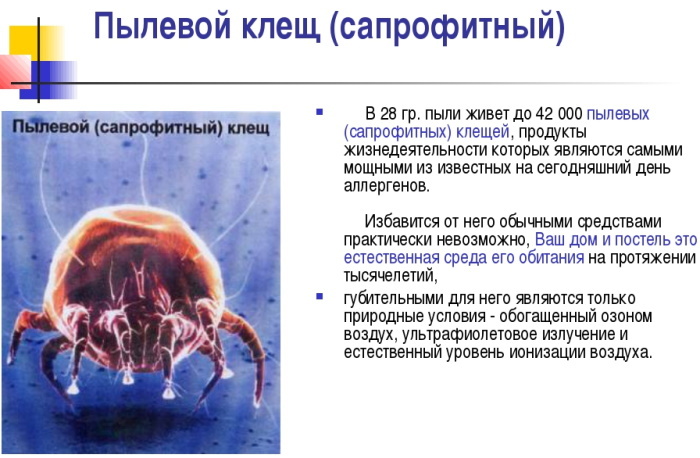
According to scientists, the population of ticks in living quarters increases when:
- a large pile of unnecessary things;
- irregular wet cleaning in hard-to-reach places;
- using old bedding and heavy curtains and drapes;
- living in dusty and gas-polluted industrial areas.
The favorite habitat of a dust mite in an apartment, according to experts, is bedding, where every day accumulates a large number of skin particles, dandruff, sweat and sebum of a person, which are considered the favorite food of parasites. Dust mites are also found in feather or down pillows, while trying to avoid high-quality synthetic bedding fillers.
Signs of appearance
A photo of a dust mite taken under a microscope allows you to see a very small parasite, completely invisible to the naked human eye. This feature makes it possible for ticks to reproduce quite calmly in apartments and houses, not showing no signs of their vital activity, up to an increase in the population up to 500 special by 1 cm.
An ordinary person cannot notice a dust mite without magnifying tools, and a characteristic sign of its appearance is sudden onset of allergic reactions such as red spots and hives, severe itching, increased tearing of the eyes and nasal sinuses.
When these symptoms appear and the absence, characteristic of colds, of a high body temperature, doctors recommend that you immediately contact an allergist and pass the appropriate tests.
According to research, young children are considered to be the most sensitive to dust mites. in whom allergic reactions often begin with a sudden cough, in the absence of a febrile states.
Harm
Unlike forest (street) ticks, domestic parasites do not bite into the human body, trying to get saturated with his blood. Danger is posed by the waste products of dust mites, containing special digestive enzymes, proteins, causing various allergic reactions in people, manifested by:
- cough;
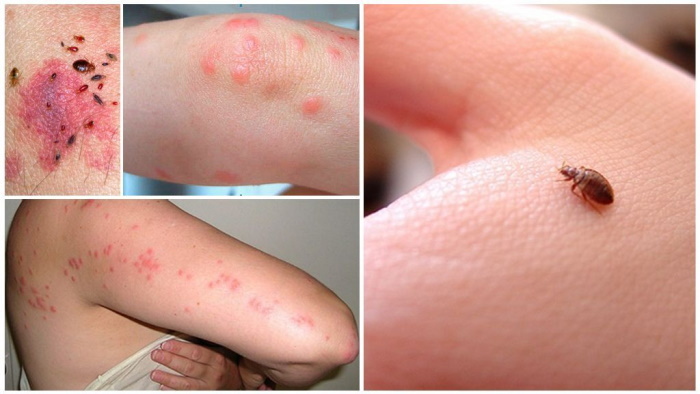
- irritation of the skin and mucous membranes;
- lacrimation;
- sneezing and chronic runny nose;
- redness in the throat;
- conjunctivitis.
Mites provoke the appearance of allergic rhinitis and dermatitis. Dust mite feces that enter the human body together with dust dissolve on the mucous membranes, simultaneously dissolving human cells with it organism, which leads to the aggressiveness of the immune system, which associates the waste products of parasites as an allergen, followed by the appearance of a strong allergic reaction.
For children
The greatest danger of parasites is for small children who are of small stature and are forced to be in relative proximity to the sex. According to statistics, 70% of children with bronchial asthma have an allergic reaction to bed mites in carpets, old books, upholstery and notebooks. Asthma worsens most often in the autumn and spring.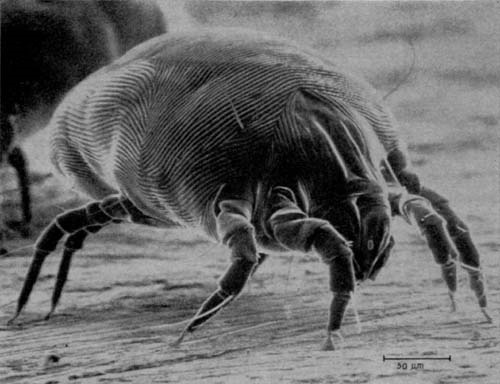
According to the results of studies conducted by scientists at the University of Massachusetts, children living in rural areas are prone to dust mite allergies several times less than their urban peers. This is due, according to scientists, to the fact that children living in the countryside from an early age regularly encounter a variety of domestic animals, in whose fur a dust mite lives.
For adults
Dust mite bites, which infect a person during a night's rest, are also dangerous to health. Unlike mosquitoes and other blood-sucking insects, when bitten by a dust mite, it injects into the human body anesthetic that lasts for 20 minutes required to saturate tick.
After the bites, the human body becomes covered with a small, urticaria-like allergic rash that provokes severe itching, aggravated in the evening and at night.
As a result of dust mite bites, the affected person experiences insomnia and mental imbalance, and severe itching, forcing to comb the bite site, can cause pathogenic microorganisms to enter the wounds, with the subsequent formation of purulent secret.
Skin dermatitis also appears when a person's skin comes into contact with the feces of field mites in bedding or upholstery. Bright red spots on the skin provoke severe itching and burning. In some cases, scabies may appear, in which the skin is covered with small red pimples, itching and itching a lot. An increase in body temperature may also be observed.
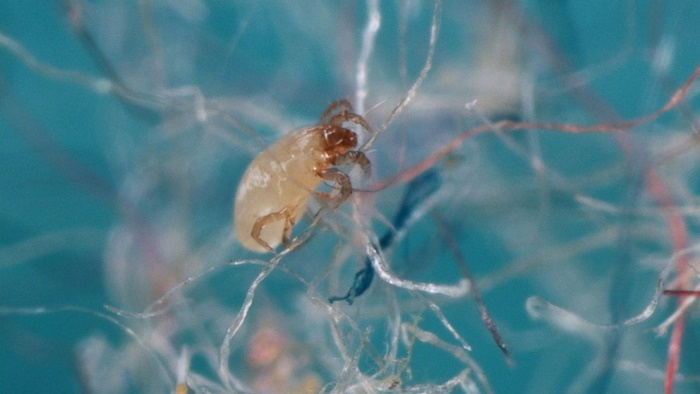
Like most parasites, dust mites are carriers of various infectious diseases, but, according to the results of laboratory studies, it was found that when a parasite bites a person, they do not transmitted.
For animals
Pets are not disturbed by bed mites. Feeding on the remains of hair and dead skin cells, the parasites do not bite a cat or dog, and do not crawl into the ears and nose. Pet hair is a favorite habitat for dust mites, which is why the animal living at home must be combed out and washed daily, especially after a walk, using a special shampoo.
In addition to the cat or dog, the favorite resting places of the animals should also be cleaned weekly: their beds and rugs.
Ways to fight
Dust mites can be dealt with only with the help of general cleaning, which consists of:
- cleaning of cluttered surfaces (including cabinets, closets and sideboards);
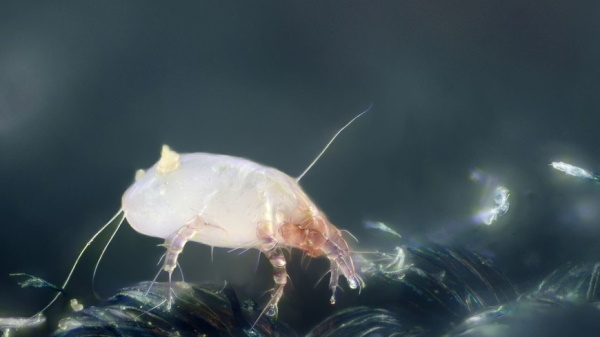
- removing and replacing old carpets with synthetic ones;
- changing heavy curtains and porter for light tulle;
- cleaning and disinfection of bedding;
- wet general cleaning of the entire apartment (including hard-to-reach places);
- washing bed linen at a temperature of at least 70 ° C, followed by ironing;
- replacing fabric upholstery with leatherette or natural leather products, as well as feather pillows for pillows filled with synthetic filler;
- cleaning all soft toys with soapy water;
- exposing furniture and bedding to the sunlight that kills dust mites.
For cleaning the apartment, experts recommend using washing vacuum cleaners that remove all kinds of allergens that have accumulated on the floor. In addition to general cleaning, special preparations are used to combat dust mites:
Medilis-Ziper
Acaricidal concentrate containing 25% cypermethrin designed to combat:
- bedbugs;

- cockroaches;
- fleas;
- midges;
- biting midges;
- mosquitoes;
- ants;
- flies;
- wasps;
- horseflies;
- various types of ticks;
- body lice.
The water concentrate used for disinfection of premises is used for the preparation of a solution and further processing of residential and non-residential premises, as well as open natural areas.
The solution affects not only adult insects, but also their larvae and acts within 2 months after application. The solution can be applied to any hard surface, and can also be used to treat upholstery, carpets and clothing.
For use against dust mites and lice, it is necessary to prepare a solution at a concentration of 0.05% and use it to irrigate or wipe surfaces. The cost of the drug is 1750 rubles.
Medilis-Permifen
Insectoctoacaricidal emulsion concentrate designed to control various types of ticks, bugs, flies and cockroaches based on 4% permethrin and 16% fenthion, which helps to remove arthropods and their larvae on objects of various categories.
For the treatment of various surfaces, including upholstery of furniture, carpets and clothes, a solution should be prepared by mixing 30 ml of the concentrate with 1 liter of water. One-time use allows you to get rid of dust mites for up to 1.5 liters. The cost of the drug is 1500 rubles.
Medilis-Super
A concentrate for combating synanthropic insects based on 24% fenthion allows you to get rid of various types of arthropods for up to 1.5 years. The concentrate approved for disinfection of residential and non-residential premises, as well as in open natural objects, is used for preparation of a solution used as wiping the surface, spraying and processing fabric and woolen surfaces, as well as clothes. 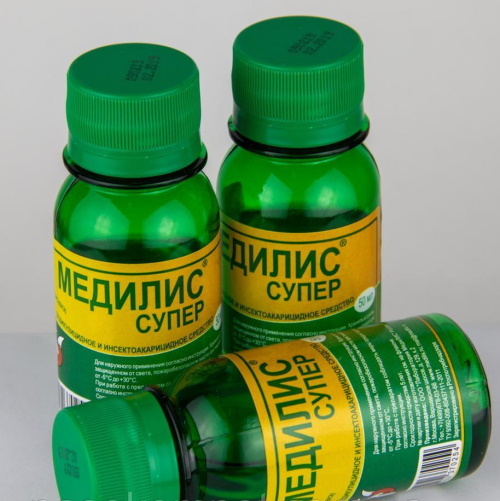 The cost of the drug is 1400 rubles.
The cost of the drug is 1400 rubles.
Dust mite allergy treatment
The following drugs help to cope with the negative reaction of the body to the actions of a dust mite:
| Medicines category | Name of items | Dosage and method of administration |
| Anti-allergy syrups and tablets (preferably 3-4 generation drugs) |
|
Tablets are taken 1 tablet per day. Gels and ointments are applied to the affected skin to relieve redness and itching 3-4 times a day. |
| Vitamin complexes that increase the body's resistance to various infections |
|
Complexes are taken 1 capsule per day. |
| Preparations that minimize irritation of the skin and mucous membranes | "Akrivastin" | A solution is used orally, 8 mg 3 times a day. |
| "Levocabastine" | Drops are prescribed from the age of 12, 1 cap 2 times conjunctivally or intranasally. | |
| Dimetindene | The drug is used both internally, in a dosage of 3-6 mg per day, divided into 2-3 doses, and externally, applying to the affected skin 2-4 times a day. | |
| Medicines to help reduce the appearance of allergic rhinitis |
|
Used to rinse the nasal cavity 3-4 times a day. |
|
The cream is used as an external agent against skin diseases and is applied to the damaged surface 3-4 times a day. |
Prevention of the appearance
Dust mites (a photo under a microscope reflects the huge number of parasites found in down pillows or woolen blankets) prefer to live and reproduce in cluttered areas with large accumulations of dust particles that provide them with nutritious environment. An effective way to prevent a negative for human health neighborhood with a parasite becomes a thorough weekly wet cleaning of the apartment, eliminating the accumulation of dust and mud particles.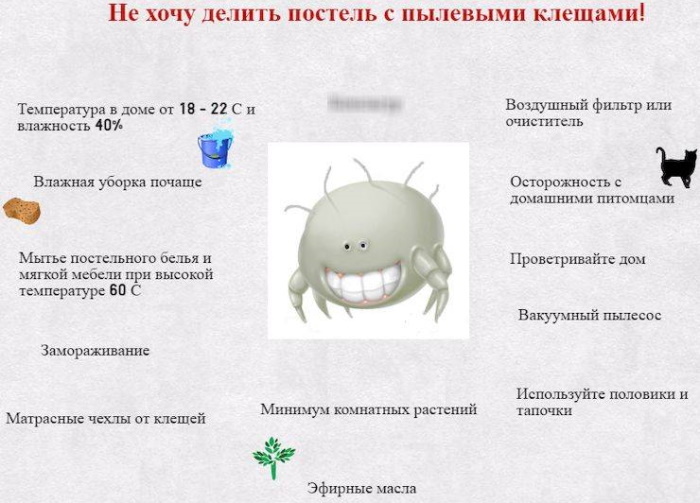
Doctors recommend:
- Change the bed linen weekly with obligatory washing at a temperature of at least + 70 ° C and subsequent ironing with a hot iron with steam.
- Daily ventilation of the living quarters (morning, afternoon and evening).
- Replacing natural wool carpets with interwoven pile carpets.
- Regular washing of underwear, followed by ironing.
- Replacement of old books and printed publications with e-books, as well as the maximum removal of soft toys and unnecessary furniture from the apartment.
- Use water with the addition of 1 tsp for general cleaning of the apartment. salt. When cleaning, special attention should be paid to furniture upholstery and carpeting, and to clean them, use a soap solution or a special detergent.
- Purchase a special removable and washable mattress cover.
- Dry bedding regularly in direct sunlight that kills dust mites.
- Clean upholstered furniture with a vacuum cleaner.
- Take heavy blankets, featherbeds, mattresses and pillows several times a year to dry cleaning, and when buying new things, give preference to products made of synthetic material.
- When choosing furniture, refuse soft models of sofas and armchairs, and replace curtains and drapes with blinds or roller shutters.
During general cleaning, allergists are advised to pay special attention to hard-to-reach places, such as corners, floor areas under carpet and furniture.
It is impossible to completely get rid of dust and mites living in it, therefore experts advise people prone to allergic diseases and bronchial asthma, clean the apartment daily, and once a week carry out a full general cleaning with the removal of all unnecessary things.
If a pet lives in the house, its wool becomes a breeding ground for the mite population, because of what the pet must be washed with a special shampoo at least 1 time a week and thoroughly daily comb out.
To make furniture surfaces unusable for dust mites, doctors it is recommended to wipe tables, shelves, upholstery and other surfaces with a solution of 1 liter of water, mixed with 1⁄2 tbsp. liquid soap and 1⁄2 tbsp. ammonia. You can also add this solution when washing bed linen.
In the winter season, it is recommended to take bed linen out into the frosty air for several hours. In a warm season, direct sunlight will help to cope with disinfection.
Dust mites are small insects resembling spiders in their structure, living in a layer of dust, woolen blankets, blankets and feather pillows. Discernible only in photographs taken using a microscope, arthropods, despite their small stature, are dangerous to humans not only their bites, but also the ability to provoke the development of a strong allergic reaction that can cause bronchial asthma or anaphylactic shock.
Dust mite videos
Malysheva on dust mites:



